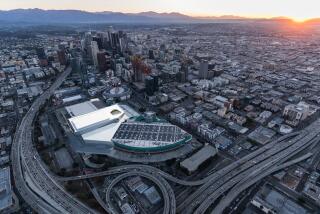St. Louis Sees Tourism, Convention Industry as Gateway to the Future : Cities: Officials are investing more than $2 billion on facilities to attract income. Some fear that the plan will drain money from other programs.
- Share via
ST. LOUIS — When last you heard about St. Louis, in the early 1980s, the good news was that the Gateway Arch was still standing. The bad news was that the city around it seemed to be crumbling.
The problems of those days--racial tensions, crumbling public housing, middle-class flight to the suburbs--all remain, and they have been joined by a business decline that has left the city’s core industries gasping for life.
But now the birthplace of the blues is seeking a rebirth, and it is betting more than $2 billion on the convention and tourism industry to make it happen.
In the next century, says Mayor Vince Schoemehl, “I think the convention industry is going to be a big, big part of how business is going to grow.”
Schoemehl believes that the city’s central location, its affordability and its historic role in the nation’s growth will help make it “an important city.” But importance doesn’t come cheap, and St. Louis is pursuing a passel of development projects, including:
- The $1.3-billion expansion of Lambert Airport, one of the nation’s busiest, to add two new runways, 40 more gates and more parking.
- A 70,000-seat domed stadium, part of a $375-million expansion of the city’s convention space. The stadium will allow the city to bid for the biggest conventions and increase its chances of landing a professional football team.
- The $300-million construction of a light rail system, connecting downtown with East St. Louis, Ill., and the airport to the west.
- The construction of a large downtown hotel. Cost: $125 million.
- The creation of a $125-million arts and entertainment district around Powell Symphony Hall and the Fox Theatre, including the construction or renovation of six performing arts venues.
- The construction of a new hockey arena for the St. Louis Blues, with a price tag of $105 million.
There are critics. Some say the city is just catching up with dozens of other cities that have already been taking advantage of meeting mania.
“One could argue that while these plans are nice, we should have been doing them 10 years ago,” said Emery Turner, dean of the St. Louis University Graduate School of Business. “I don’t see this giving the area a big boost.”
City Comptroller Virvus Jones, meanwhile, is worried about where the money will come from to pay for all of this.
“All these things are great, but you can’t do them regardless of cost. If we have to pay for a domed stadium and we don’t have enough money left to buy salt for the roads, I don’t think people are going to be too happy,” he said.
Jones said the stadium alone will pull $6 million out of already stretched city coffers each year for 30 years.
But city officials say bad times in the defense and auto industries, key to St. Louis’ economic health, point up the need to diversify.
McDonnell Douglas Corp., the nation’s biggest defense contractor, laid off 5,600 workers earlier this year and Chrysler Corp. plans to close a plant in May that will idle 3,000 workers.
And there is no sign that the decline in manufacturing jobs, which has been under way since the late ‘70s, is going to change.
In pushing to expand the convention and tourism industry, St. Louis officials are harking back to a more glorious, less troubled past.
In 1904, St. Louis was the home to both the Olympics, the first held in this country, and the World’s Fair, where hot dogs, iced tea and ice cream cones were popularized.
“In my dreams we’ll do it again,” said Keith Arnold, president of the city’s convention and visitors commission. “But for now we want to see an NCAA Final Four or a Super Bowl.”
More to Read
Sign up for Essential California
The most important California stories and recommendations in your inbox every morning.
You may occasionally receive promotional content from the Los Angeles Times.













